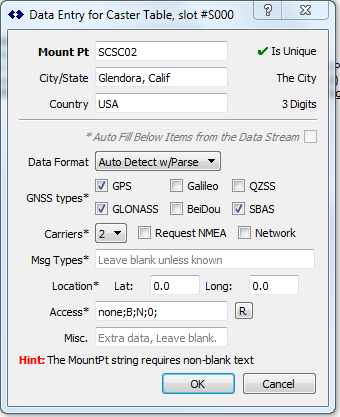When creating a new data stream (typically from a local serial data source) you must supply SNIP with certain basic data about the stream. This article describes this process and how to use the Caster Table Data Entry dialog.
Background
The data you provide will be used in the caster table entry for this mount point by your potential NTRIP clients. While you can in fact publish a data stream with a very incomplete caster table entry, speaking on a technical level this is poor practice and should be avoided. The dialogs and wizards provided by SNIP make this an easy process to complete. SNIP will remember the values you establish and use them with this stream thereafter.
Aside: You only need to enter caster table details for caster table entries (mountPts) that you create. You do not need to enter them for caster tables which you reuse from other NTRIP Casters (such as your remote-relay connections). SNIP will automatically gather these up for you and correctly place them in your local caster table. When you send a PUSH-out data stream to another caster, your local caster table entry is sent along with it automatically. When a new PUSH-in data stream first connects to your SNIP Caster, it either brings a suitable caster table with it or SNIP will create a suitable one for it.
In the below, items with the term autoset will be automatically set by SNIP for you if that stream is set to be parsed.
The dialog
The key data itself entered in the Caster Table Data Entry dialog shown below.

The mountPt
The mountPt is the unique name you give this stream. Ideally it should be short and follow a consistent pattern such as four capital letters; but with >30k mountPts out there that is not easy to do. If your users will be typing on a PDA at least make it short for them (and that is one time a lower case name may be best). If you will have different data feeds from the same source (RTCM 2.3 and RTCM 3.x for example), you could add that to the name as well. As you look about you will see different networks use different patterns. Find one you like an try to follow it. Remember: Case matters.
It is the only required element in the entry. SNIP will ensure that it is unique if you were to set up multiple streams with the same names.
City / State
This string can be used for a place name “My Town, My State” if you like, or left blank. It is optional.
Country
This should be the three digit ISO-3166 code for the country the caster is located in. Here is a handy lookup table for these codes. It is optional.
Data Format
The precise type of data the stream has, used to tell the NTRIP Client what the data is, and therefore the Client can decide if it can decode and use it. While this is also defined in the standard as free text, certain phrases (all in the drop down) are preferred. The various data formats supported by SNIP are further discussed in this article. It is optional. It is autoset if the stream is parsed.
GNSS Type
The type(s) of GNSS data being sent in this stream, GPS, GLONASS, QZSS, Galileo, BeiDou (Compass), SBAS/WASS, etc. It is optional. It is autoset if the stream is parsed.
Msg Types
A free form list of the message types found in the stream. Many times it can also have the data rates. Often this field is not correctly set or reflects message that are not in fact present. This is often true with RTCM 2.x data streams. It is optional. It is autoset if the stream is parsed. When the messages are determined from parsing the stream, the initial set of values is used is gathered from the first ~120 seconds of operation. This is latter updated after the stream has been operational or ~15 minutes to remove any rounding in the message sending rates that may have occurred.
Location (gross Latitude and Longitude)
The location of the data source to 0.01 degrees. It is used to help the client select which data source is closest to their rover device. In virtual reference station data streams this is often left as zero, zero. [The RTCM SC-104 recommends that the value be set to the middle of the service area rather than zero, zero.] It is optional. It is autoset is the stream is parsed.
In summary
So the shortest caster table entry one can have consists of just the unique mountPt name. SNIP will fill in the rest of the details when it can. Here is an example of a terse but valid caster stream for a mountPt called “Test”
STR;Test;;;;;;SNIP;;0.00;0.00;1;;sNTRIP;;N;;;;
Using Local Defaults
The value for your city/state string, your country string, and your lat-long location can be automatically filled in for a new empty stream if you first set these values in your preferences dialog.
But I am in a Hurry…
Proceed as follows:
- Create a unique MountPt name to use; the hints will assist you with this.
- Leave the data format set to a blank value, indicating it is unknown.
- Leave the GNSS type set to a blank value, indicating it is unknown.
- Leave the lat-long set to 0,0 (if the data is RTCM3 format and it is parsed, these will be filled in for you).
- Leave the message types empty (f the data is RTCM3 format and it is parsed, these will be filled in for you after about ~120 seconds of observation time).
You are done. Hit return. Be sure to come back later and fix this (i.e. at least add the city/state when the data comes from) when conditions allow.
